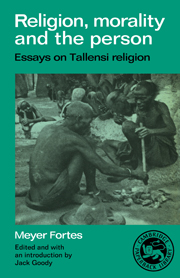Book contents
- Frontmatter
- Contents
- List of figures
- Introduction by Jack Goody
- 1 Divination: religious premisses and logical techniques
- 2 Prayer
- 3 Ritual festivals and the ancestors
- 4 Ancestor worship in Africa
- 5 Ritual and office
- 6 Totem and taboo
- 7 Coping with destiny
- 8 Custom and conscience
- 9 The first born
- 10 The concept of the person
- Endpiece: sacrifice among theologians and anthropologists
- Notes
- References
- Index
4 - Ancestor worship in Africa
Published online by Cambridge University Press: 13 October 2009
- Frontmatter
- Contents
- List of figures
- Introduction by Jack Goody
- 1 Divination: religious premisses and logical techniques
- 2 Prayer
- 3 Ritual festivals and the ancestors
- 4 Ancestor worship in Africa
- 5 Ritual and office
- 6 Totem and taboo
- 7 Coping with destiny
- 8 Custom and conscience
- 9 The first born
- 10 The concept of the person
- Endpiece: sacrifice among theologians and anthropologists
- Notes
- References
- Index
Summary
It has long been recognized that ancestor worship is a conspicuous feature of African religious systems (cf. Tylor 1971, II, p. 115; Smith 1950). Among the Tallensi of Ghana, as I have shown in previous publications, it so pervades their social life as to put them on a par with the Chinese and the Romans in this respect. To a greater or lesser degree this holds for all the peoples of Negro stock in Africa.
There is general agreement that, wherever it occurs, ancestor worship is rooted in domestic, kinship and descent relations, and institutions. It is described by some as an extension of these relations to the supernatural sphere, by others as a reflection of these relations, yet again as their ritual and symbolic expression.
Comparatively viewed, African ancestor worship has a markedly uniform structural framework. The congregation of worshippers invariably comprises either an exclusive common descent group, or such a group augmented by collateral cognates, who may be of restricted or specified filiative provenance or may come from an unrestricted range; or else the worshippers in a given situation may comprise only a domestic group, be it an elementary family or a family of an extended type.
In the paradigmatic case, congregations of the first kind represent ancestor worship in the structural context of the corporate lineage; and those of the second kind show us its family context. Here spouses, who are, of course, formally affines, not kin, participate by right of marriage and parenthood, not of descent or filiation, as do members of the first kind of congregation.
- Type
- Chapter
- Information
- Religion, Morality and the PersonEssays on Tallensi Religion, pp. 66 - 83Publisher: Cambridge University PressPrint publication year: 1987
- 15
- Cited by



